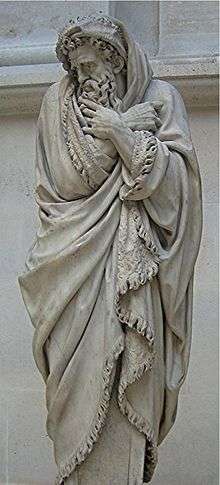Pierre Le Gros the Elder

Pierre Le Gros the Elder (1629 – 11 May 1714) was a French sculptor whose output was largely absorbed by the decoration of the château and the gardens of Versailles, often working to designs provided by Charles Le Brun (like for L'Eau (the Water)) and collaborating with other sculptors of the Bâtiments du Roi. His son, Pierre Le Gros the Younger worked almost entirely in Rome.
The elder Le Gros was born at Chartres and was a pupil of Jacques Sarrazin. He was received into the Académie in 1666 and completed many commissions for Versailles including statues in bronze and marble, bas reliefs and fountains. At Versailles, his bronze fountain sculpture of a cupid, "the Genius of Royal Power" seated on an eagle that ejected a spout of water, was engraved by Jean le Pautre (his father-in-law) in the 1670s[1] as part of the series of images that helped disseminate the Baroque Classicism of Versailles throughout Europe.
Another fountain sculpture for Versailles, Cherubs Playing with a Lyre, of 1672-1673, was removed from Versailles in the mid-eighteenth century and is now in the National Gallery of Art, Washington DC.[2]
Projects for the Bâtiments du Roi were distinctly a coordinated cooperative affair. A case in point is the Porte Saint-Martin in Paris, designed by Pierre Bullet and carried out between 1672 and 1674. The team of sculptors providing bas-reliefs for the spandrels of the monumental rusticated triumphal arch were Gaspard Marsy, Pierre Legros, Etienne Le Hongre and Martin Desjardins and their assistants. Le Gros' contribution was The Capture of Limburg, 1675, but the subject, a seated woman by a supine lion, was dictated to Le Gros, and the general composition as well.
His herms representing the Four Seasons are conserved in the Louvre Museum
His first wife, Jeanne (married 1663, died 1668), was the sister of the sculptors Gaspard and Balthazard Marsy, his second wife, Marie (married 1669), was the daughter of the engraver Jean le Pautre.[3]
He died in Paris.
Notes
- ↑ He was credited as "Pierre le Gros de Chartres."
- ↑ Cherubs Playing with a Lyre
- ↑ see: Thomas Hedin, The Sculpture of Gaspard and Balthazard Marsy, Columbia (University of Missouri Press) 1983.
References
- (Getty Museum) Union list of artiosts' names
- Souchal, François. French Sculptors of the 17th and 18th Centuries: The Reign of Louis XIV. 4 vols (supplement 1993). (London, Cassirer and Faber), 1977-93.
- (National Gallery of Art), Sculpture: An Illustrated Catalogue 1994: 131
External links
- Pierre Le Gros the Elder in American public collections, on the French Sculpture Census website